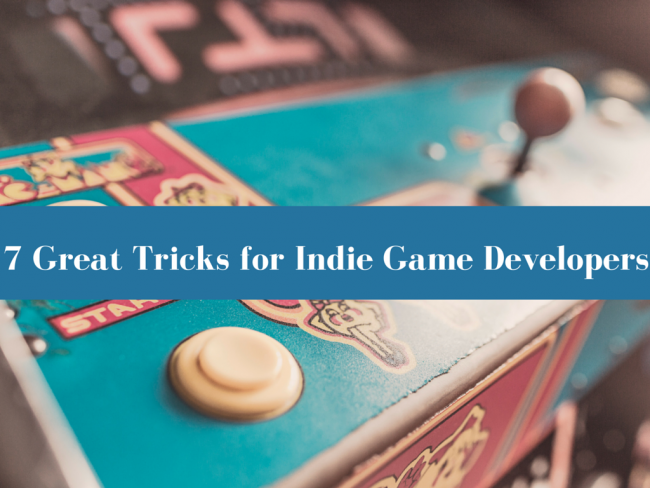
Game Development is a lucrative profession. It requires expert knowledge in multiple fields including mathematics, programming, psychology, game design, audio, etc with an ultimate challenge even to the best. With tons of resources available online, it is easy to get started with game development.
Indie game developers find it harder to sustain in the industry than compared to game developers who work on big projects and do not suffer from the problems of resource management. It is a common practice by indie game developers to copy ideas and improve them accordingly. Nintendo recently released their blockbuster game Pokemon Go, which can be imitated by indie game developers and gain access to the newly found market, the augmented reality.
It’s not that big game development companies don’t need resource management, but it is low on the priority list. There are other factors that also affect indie game developers and that’s why we will discuss some great tricks and tips for Indie game developers to overcome some common problems.
Livecoding has seen many game developers over the past one year. With over hundreds of game projects completed on Livecoding, it is easy to say that more and more developers are moving towards game development. Some of the key game developers on Livecoding are as follows.
- Phanxgames: Phanxgames from Washington DC, US, is developing RpgLegend, a complete in-development 2D multiplayer with a touch of the 16-bit era. The game looks interesting, and you can watch it developed live on his channel. The game will be first released on Indows, followed by Mac OSX, and other platforms. Check out the official webpage here.
- Brodie124: Brodie124 from Chester, UK is working for their upcoming games BSOD. BSOD(Blue Screen of Death) is a multiplayer based virtual hacking game. He manages all the networking and logical programming is of the system. He is working for Underdog games. You can catch all the live development by checking out their channel. The studio has also collaborated with other indie game developers in the past and shows the genuine spirit of indie game development. Read point six for more.
- Whilke: Whilke, working for Enbask studio, is currently developing Enderkend Station, a survival game based on a distant planet. You can check some aspects of the game developed live by following the channel here.
- Toorop: Toorop from France works on different types of projects including games. Currently, he is building a chatbot, and you can follow him here.
- Jpain: Jpain, developer at Ve Interactive is currently working on Pokemon Go API’s. Pokemon Go has caught the attention of the world, and Jpain is making API’s work with the game. Catch him live by following his channel here.
So, why wait? Let’s get started.
1. Using Old Assets
As we have already mentioned, resource management is crucial for indie game developers. The rule is simple, try to utilize as much resource as you can from your repository. It can be a design, code or technique that you used earlier.
Not only you are saving precious time, but you are also adding value to your project by using old resources. If you are worried about the similarity to previous game release, tinker enough to make it unique. In the end, you save both time and production cost.

Even Super Mario agrees to the point.
2. Don’t reinvent the wheel
Starting a new project can be a great experience for an indie game developer. The new project either be personal project or a freelance project. Nevertheless, in both cases, it is easy to get lost in reinventing the wheel. If you find yourself creating the 2D images or full-fledged functions to move the character in your game, you are doing it wrong.
Instead, utilizing the already available libraries, engine or tools is a better move. Not only you are saving a lot of your time in creating trivial things, but you are also utilizing the time in developing game mechanics, designing the game and building other core aspects of the game.
3. Take advantage of Digital Distribution
Digital distribution has now become a common theme among game companies to distribute the game. As an indie game developer, you too should also opt for digital distribution and cut the cost to a fraction of getting physical copies to the market. Digital distribution has become ubiquitous, thanks to the increasing internet speeds across the world.
4. Procedural Generation
Procedural generation is a key topic in game industry. It is all about letting the machine do the stuff using procedural algorithms. Procedural generation became popular with indie game development as it is evident that it will benefit the team much more compared to generating game assets or content manually.
With procedural generation, the content(such as quest, monsters, textures, audio) can be endlessly generated according to a specific algorithm. The algorithm, of course, needs to be defined by the developer itself. New Man’s Sky uses procedural generation to new heights. According to the developer, the game offers more 5 billion years of gameplay. Another great example of procedural generation is Minecraft.
5. Use Free Open Technology
Open technology is everywhere. For indie game developers, it is vital to utilize the open technologies(free) and build games with minimal cost. One great example is Counter Strike, which took Half life engine as it’s base, tweaked it and ended as the world’s best multiplayer shooter out there.
The example clearly showcases the endless possibilities that an indie game developer currently has. Some example of open technology are Python, SDL, OpenAL, HawkNL, Navi, etc.
6. Steam Your Game Development Live
Lone shark doesn’t survive long in the game industry, especially when it comes to indie game development. The only way to survive is to collaborate with similar developers and ask them for free resources. Furthermore, you can take advantage of Livecoding that lets you broadcast your game development to the world.
Not only your work will be appreciated, but you will also get help from fellow indie game developers and veterans. You can also join forums to discuss your problems and get quick solutions. StackOverFlow is your biggest friend and will help you go through 90% of your problems.

Collaboration can lead to happy times.
7. Develop Multiplayer
Single player games are awesome. Most single player games are rich in story, gameplay, and art design. But, that doesn’t mean you as an indie developer should ignore multiplayer altogether. Multiplayer prospects are much more than single player and easily target different player base. The only problem here is resource and production cost. If game budget allows you to develop multiplayer aspects, then go forward and make it happen!
Conclusion
Game development is a vast field to explore. It has common grounds with different fields, and it is extremely challenging from the start. As a indie game developer, you also know how difficult game development is.
If you find the tricks or tips amazing, then don’t forget to share it with your friends and family. Also, share what you think about indie game development and the challenges it brings to you.







